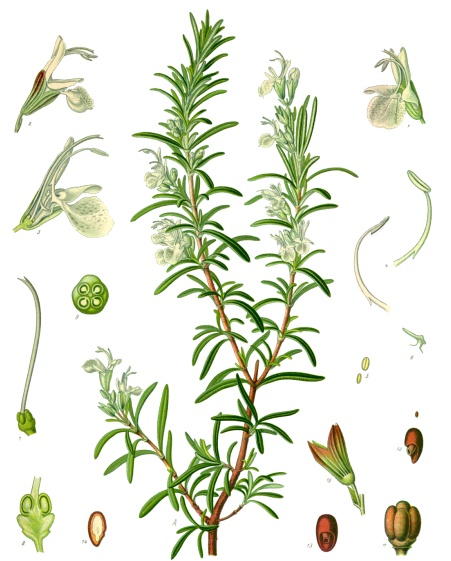
Rosmarinus officinalis (L)
 Synonyms and Common names: Polar plant, Compass weed, Compass plant
Synonyms and Common names: Polar plant, Compass weed, Compass plant
French=Romarin or Encensier, German = Rosmarin, Spanish = Romere, Italian = Rosarine
Order: Labiatae
Description: Rosemary is an evergreen shrub indigenous to Southern Europe, particularly on the dry rocky hills of the Mediterranean region. The numerous branches have an ash-coloured scaly bark and bear opposite, narrow, revolute, leathery, thick leaves which are lustrous and dark green above and downy white underneath. They have a prominent vein in the middle and margins which are rolled down. The pale blue, sometimes white, labiate flowers grow in short axillary racemes and appear between April and June, slightly later in cooler climates.
Parts used: leaves and twigs, oil
Collection: The leaves can be harvested at any time although they are at their best during the flowering period.
Constituents: About 1% volatile oil (containing 2-5% esters, mainly borneol acetate and 10-18% free alcohols including borneol and linalol), camphor, camphene and cineole; flavonoids (diosmin, apigenin, diosmetin, genkwanin, 6-methoxygenkwanin, hispidulin, sinensetin, luteolin and derivatives), phenolic acids (rosmarinic and others); diterpenes such as carnosilic acid , picrosalvin (carnosol), and rosmariquinone; triterpenic acids (ursolic and oleanic acids and derivatives); carnosic acid (rosmaricine)
Actions: carminative, stomachic, aromatic, spasmolytic, thymoleptic, antiseptic, anti-inflammatory, diaphoretic, stimulant to the peripheral circulation, sedative, antidepressive, relaxant, restorative to the nervous system, reputed cardiac tonic, cholagogue, diuretic, emmenagogue, antimicrobial. Topically rubefacient, mild analgesic and parasiticide
Indications: Flatulent dyspepsia associated with psychogenic tension, migrainous, vasoconstrictive or hypertensive headaches. Topically for myalgia, sciatica and intercostal neuralgia.
Therapeutics and Pharmacology: Rosmarinus is specifically indicated in depressive states accompanied by general debility and indications of cardiovascular weakness and is of value as a tonic for elderly people with weak circulation, particularly after a debilitating illness such as influenza and pneumonia. The flavonoid diosmin improves the circulation and strengthens fragile blood vessels. Diosmin is reported to be more effective in decreasing capillary fragility than rutin. The herb is of benefit in palpitations and other signs of nervous tension which affect the circulation. The camphor has a general tonic effect on the circulation and nervous system, especially the vascular nerves, making it an excellent drug for all states of chronic circulatory weakness including hypotension.
Rosmarinus is beneficial in dyspeptic conditions with flatulence and signs of liver inadequacy. It is of particular value in atonic conditions of the stomach where there is also generally poor circulation. The herb reduces flatulence and is stimulating to the digestion, liver and gallbladder, increasing the flow of bile; as rosmaricine breaks down in the body it stimulates the smooth muscle of the digestive tract and gallbladder. An infusion makes a good mouthwash for halitosis.
Externally, Rosmarinus is used to ease muscular pain, sciatica and neuralgia, and the oil is a component of liniments used for rheumatism. A salve made from the oil can be applied to sores, eczema, bruises and wounds. The anti-inflammatory action of the herb is thought to be due to rosmarinic acid, ursolic acid and apigenin.
It is an excellent remedy for headache, taken either as an infusion or by applying the oil to the temples. Rosemarinus can also be applied locally as a wash for dandruff and scurf, or added to a bath for a stimulating effect. It has been used since ancient times to improve and strengthen the memory.
The oil also possesses antibacterial and antifungal properties, and antimicrobial activity has been documented towards moulds and Gram-positive and Gram-negative bacteria including Staphylococcus aureus, Staphylococcus albus, Vibrio cholerae and Escherichia coli. Carnosol and ursolic acid inhibit a range of food spoilage bacteria.
Combinations: Rosmarinus may be combined with Avena, Cola and Verbena in depression, and with Salvia, Gelsemium and Valeriana in migraine.
Caution: Rosmarinus should be avoided during pregnancy because it is a uterine stimulant. Excessive amounts can cause symptoms of poisoning.
Preparation and Dosage: (thrice daily)
Regulatory Status: GSL
Dried leaves and twigs: 2-4g or by infusion
Liquid Extract: 1:1 in 45% alcohol, 2-4ml
Additional Comments: Rosemary was reputedly first grown in England by Philippa of Hainault, wife of Edward III, in the 14th century. Gerard said of the herb, 'it comforteth the harte and maketh it merie'. Grown in gardens since ancient times, it was considered to have powers of protection against evil spirits and was the emblem of fidelity for lovers. It is said that rosemary grows well in the kitchen gardens of households where the woman reigns supreme. It is an ingredient of many shampoos and hair preparations, and an infusion of the herb with borax is used as a rinse for treating dandruff. The leaves are one of the ingredients of eau de cologne.
Bibliography
Bartram, T. 1995 Encyclopaedia of Herbal Medicine, 1st edn., Grace Publishers, Bournemouth.
Bremness, L. 1994 Herbs, Dorling Kindersley Eyewitness Handbook, London.
BHMA 1983 British Herbal Pharmacopoeia, BHMA, Bournemouth.
Chevallier, A. 1996 The Encyclopaedia of Medicinal Plants, Dorling Kindersley, London.
Grieve, M. 1931 A Modern Herbal, (ed. C.F. Leyel 1985), London.
Hoffmann, D. 1990 The New Holistic Herbal, Second Edition, Element, Shaftesbury.
Hyperhealth 1996 Natural Health and Nutrition Databank, v.96.1 CD-ROM, �In-Tele-Health
Lust, J. 1990 The Herb Book, Bantam, London.
Mabey, R. (ed.) 1991 The Complete New Herbal, Penguin, London.
Mills, S.Y. 1993 The A-Z of Modern Herbalism, Diamond Books, London.
Newall, C.A., Anderson, L.A., & Phillipson, J.D. 1996 Herbal Medicines: A Guide for Health-care Professionals, The Pharmaceutical Press, London.
Ody, P. 1993 The Herb Society's Complete Medicinal Herbal, Dorling Kindersley, London.
Polunin, M. and Robbins, C. 1992 The Natural Pharmacy, Dorling Kindersley, London.
Vickery, R. 1995 A Dictionary of Plant Lore, Oxford University Press.
Weiss, R.F. 1991 Herbal Medicine, Beaconsfield Arcanum, Beaconsfield.
Wren, R.C. 1988 Potter's New Cyclopaedia of Botanical Drugs and Preparations, C.W.Daniel, Saffron Walden.










